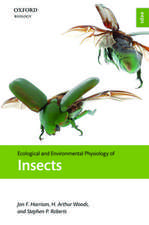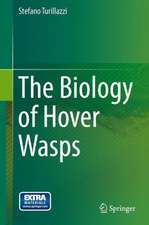Planthoppers: Their Ecology and Management
Editat de R. F. Denno, John R. Perfecten Limba Engleză Hardback – 29 sep 1993
| Toate formatele și edițiile | Preț | Express |
|---|---|---|
| Paperback (1) | 1567.84 lei 6-8 săpt. | |
| Springer Us – 5 oct 2012 | 1567.84 lei 6-8 săpt. | |
| Hardback (1) | 1847.70 lei 6-8 săpt. | |
| Springer Us – 29 sep 1993 | 1847.70 lei 6-8 săpt. |
Preț: 1847.70 lei
Preț vechi: 2253.29 lei
-18% Nou
Puncte Express: 2772
Preț estimativ în valută:
353.67€ • 384.29$ • 297.27£
353.67€ • 384.29$ • 297.27£
Carte tipărită la comandă
Livrare economică 21 aprilie-05 mai
Preluare comenzi: 021 569.72.76
Specificații
ISBN-13: 9780412023415
ISBN-10: 0412023415
Pagini: 799
Ilustrații: X, 799 p.
Dimensiuni: 155 x 235 x 49 mm
Greutate: 1.33 kg
Ediția:1994
Editura: Springer Us
Colecția Springer
Locul publicării:New York, NY, United States
ISBN-10: 0412023415
Pagini: 799
Ilustrații: X, 799 p.
Dimensiuni: 155 x 235 x 49 mm
Greutate: 1.33 kg
Ediția:1994
Editura: Springer Us
Colecția Springer
Locul publicării:New York, NY, United States
Public țintă
ResearchDescriere
Planthoppers include some of the most devastating pests of major agricultural crops throughout the world. One species, the rice brown planthopper, is among the most economically important pests in Asia. In past decades, government policies encouraged the control of rice planthoppers with synthetic pesticides, a tactic which promoted insecticide resistance and often led to the pesticide-induced resurgence of pest populations. To deter planthopper outbreaks, a more ecologically sound management strategy is being implemented, one based on a thorough investigation of population dynamics, natural enemies, and the genetics of host plant and insecticide adaptation. In the natural habitats of North America and Europe, scientists have also used planthoppers as model organisms to test ecological and evolutionary theory. The consequence of these diverse studies is an extremely scattered literature on planthoppers that has never been synthesized from an ecological perspective. This volume summarizes what is known about planthopper ecology and biological control. It takes a theoretical approach yet is deeply concerned with the application of theory to the practical problems of pest management.
Cuprins
Contributors; Introduction: planthoppers as models for ecological study and effective pest management-- Robert F. Denno and T. John Perfect; Part I: Host plant relationships: Evolutionary patterns of host plant use by Delphacid planthoppers and their relatives-- Stephen W. Wilson, Charles Mitter, Robert F. Denno and Michael R. Wilson; Planthopper/plant interactions: feeding behavior, plant nutrition, plant defense, and host plant specialization-- Anthea G. Cook and Robert F. Denno; Influence of habitat structure on the abundance and diversity of planthoppers-- Robert F. Denno; Part II: Life history patterns, reproductive biology, and speciation: Life history variation in planthoppers-- Robert F. Denno; Reproductive behavior: the role of acoustic signals in species recognition and speciation-- Michael F. Claridge and Peter W. F. de Vrijer; An ecological framework for the study of planthopper mating systems-- James R. Ott; Part III: Population ecology: Density-related effects on the components of fitness and population dynamics of planthoppers-- Robert F. Denno, Jiaan Cheng, George K. Roderick and T. John Perfect; Rice planthopper population dynamics: a comparison between temperate and tropical regions-- T. John Perfect and Anthea G. Cook; Long-distance migration in Delphacid planthoppers-- Ryoiti Kisimoto and L. Jane Rosenberg; Part IV: Species interactions and community structure: Predator-planthopper interactions-- Hartmut G. Dobel and Robert F. Denno; Parasitoid interactions and their contribution to the stabilization of Auchenorrhyncha populations-- James T. Cronin and Donald R. Strong; Transmission biology, vector specificity, and evolution of planthopper-transmitted viruses-- Lowell R. Nault; Interspecific interactions and community structure in planthoppers and leafhoppers-- Peter D. Stiling; Part V: Ecological approaches to planthopper management: Biological control in the management of planthopper populations-- Betty Benrey and William O. Lamp; Genetics of host plant adaptation in Delphacid planthoppers-- George K. Roderick; Impact of insecticides on the resistance and resurgence of rice planthoppers-- Elvis A. Heinrichs; Judicial use of insecticides deters planthopper outbreaks and extends the life of resistant varieties in Southeast Asian rice-- Kevin D. Gallagher, Peter E. Kenmore, and Kazushige Sogawa; Status and prospects for an integrated approach to the control of rice planthoppers-- J. Daniel Hare; Part VI: Definition and implementation of management options: A systems approach to planthopper population dynamics and its contribution to the definition of pest management options-- Jiaan Cheng, Johnson Holt, and Geoff A. Norton; Extension of integrated pest management for planthoppers in Asian irrigated rice: empowering the user-- Patricia C. Matteson, Kevin D. Gallagher and Peter E. Kenmore; References; Taxonomic index; Subject index.
Recenzii
The text is clearly organized. The chapter summaries are particularly useful............The last chapter is the most interesting as it details the problems and solutions of implementing an effective IPM educational program in rural Asia...........It is a useful compilation of scattered data...Over 1700 references are listed, of which 83% represent papers published in the last quarter century....... - Entomological Society of America; The text is clearly organized. The chapter summaries are particularly useful............The last chapter is the most interesting as it details the problems and solutions of implementing an effective IPM educational program in rural Asia...........It is a useful compilation of scattered data...Over 1700 references are listed, of which 83% represent papers published in the last quarter century....... - Entomological Society of America; The text is clearly organized. The chapter summaries are particularly useful............The last chapter is the most interesting as it details the problems and solutions of implementing an effective IPM educational program in rural Asia...........It is a useful compilation of scattered data...Over 1700 references are listed, of which 83% represent papers published in the last quarter century....... - Entomological Society of America











